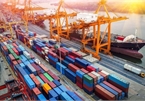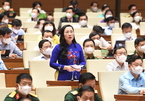
In 2019, the Prime Minister asked to re-assess the scale of the economy, including GDP. With the General Statistics Office (GSO) recalculation, the GDP is 25 percent higher than the official figure. However, economists still disagree on the issue.
GDP recalculation is implemented regularly by other countries and Vietnam is not a particular phenomenon.
In 2017 alone, the recalculated GDP of 158 countries increased by 31 percent on average. The sharpest increase was seen in Zimbabwe (over 60 percent), while the lowest was in Switzerland (7 percent). Meanwhile, the figures were 19 percent in Italy and 17 percent in Spain.
As for Vietnam, Fulbright University’s calculation is 25-30 percent higher than the officially released statistics. Hopefully, from 2021, the first year of the new five-year development plan, the recalculation will become routine.
Four major reasons
The GDP recalculation is not intended to improve Vietnam’s position in the world’s ranking of economies, but just to respect the truth that the size of the economy is larger than that shown in official statistics.
GSO has pointed out four major reasons behind this, including the survey and data collection capability and the lack of a policy on calculating the informal economy. The third reason is that Vietnam doesn’t acknowledge the illegal economy. The fourth reason is the fear that this would lead to Vietnam’s higher customary contribution duties to international organizations.
Illegal economy is considered consistent with Vietnam's concept about rule of virtue, which considers ‘illegal’ synonymous with ‘unethical’. However, there should be a limit for the illegal economic sector, or a clear distinction between the illegal economy and the economic types with nonstandard names such as the underground economy and the black economy.
| A particularity of Vietnam’s economy is the existence of the ‘housewife’ economy in every family, a self-sufficient economy in both urban and rural areas. |
Many countries have been recalculating GDP. Some of them count the ‘prostitution economy’, some others that did not have re-calculated.
Calculating the ‘counterfeit and copied goods’ economy is also a matter of concern. This type of economy is clearly illegal. A lot of counterfeited goods production and trade cases have been discovered, but the remaining are still produced, circulated and monetized in the market as real types of goods.
Does the exclusion of “fake goods” when calculating GDP fall short of the definition of this indicator? A proportion of fake goods, which is believed to be not small and increasingly high, has been crossing the northern border, which shows that the top economies in the world do not exclude this type of economy. And maybe fake goods are considered a component of its economy.
If Vietnam doesn’t count this type of economy, will it be unfair to Vietnam in the global economic ranking?
Informal economy
This type of economy began developing when the centrally planned economy faced setbacks. In rural areas, informal economy became the lifebuoy for millions of households.
Some economists commented that the ‘5 percent land’ created 95 percent of households’ income (in the past, 95 percent of agriculture land bank belonged to cooperatives, while the remaining 5 percent was allocated to farming households for development. This land is called ‘5 percent land’). Meanwhile, the ’95 percent land’ created a modest 5 percent.
Since 1992, the income from the 5 percent land has not been counted when calculating GDP.
In urban areas, in the system of state-owned enterprises, the so called ‘3-part plan’ appeared. The first part was ‘doing 100 percent for the state’. The second was ‘doing partially for the State and partially for the market’. The third was ‘doing 100 percent for enterprises’.
The first part was to fulfill the obligations to the state. The second part aimed to maintain the existence of enterprises. And the third part aimed to improve the income of workers in enterprises.
The second and third part belonged to the informal economy, and as a matter of course, they have not been counted in when calculating GDP.
Informal economy also includes the self-sufficient economy, existing in both rural and urban areas. This is a special characteristic of Vietnam’s economy, existing since the planned economy.
This is the ‘housewife economy’ in every family. The country has 25 million households and the same number of ‘housewives’ with the market price of VND7 million a month in cities and VND3 million in rural areas.
This is the self-production and self-consumption scheme of families in rural areas. They may not have to buy rice, but have to prepare meals. They may not have to buy vegetables, fish, eggs and meat, but still have to have different dishes on dining tables. If they cannot produce that fresh food, they have to buy the food in the market, at no less than VND2 million for each person in families per month.
Meanwhile, the subsistence economy has not been taken into account when calculating GDP. This could be correct for developed economies, but not for Vietnam, which is switching to the market economy and there are still economic parts which have not been monetized.
Because of neglect, Vietnam’s GDP valuation was $31 billion in 2000 and GDP per capita at $403, after it entered the doi moi reform period in 1986. With that level, 100 percent of people were considered poor. Meanwhile, the real proportion was just 29 percent and Vietnam even fulfilled the UN millennium goal on poverty eradication by 2006, reaching the finish line 10 years ahead of time.
This also explaind why Vietnam’s GDP was only $101 billion in 2010 and reached $202 billion six years later and $340 billion in 2020.
Dr. Dinh Duc Sinh

Vietnam’s exports up 25.5 pct in seven months
Vietnam’s export earning hit 27 billion USD in July, down 0.8 percent month-on-month and up 8.4 percent year-on-year, reported the General Statistics Office (GSO) on July 29.

VN is like a living organism that mustn’t be cut apart because of pandemic
How to organize social distancing while still ensuring uninterrupted production and goods circulation is uppermost in agencies' thoughts.